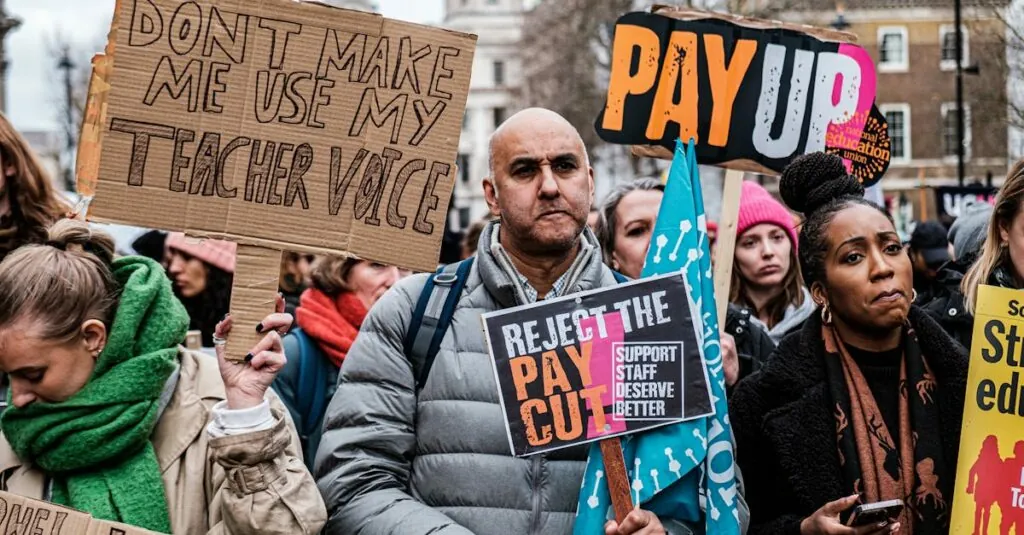Table of Contents
ToggleIn today’s public education landscape, the debate between equality and equity resembles a high-stakes game of tug-of-war. On one side, equality champions the idea that every student should get the same resources. On the other, equity argues for a tailored approach that meets individual needs. It’s like trying to fit a square peg in a round hole—sometimes you need to break out the saw.
Navigating this complex issue can feel like walking a tightrope while juggling flaming torches. Educators and policymakers are constantly challenged to find a balance that ensures all students thrive, regardless of their backgrounds. With so much at stake, it’s time to dive into how we can harmonize these two concepts and create an educational system that truly serves everyone.
Understanding Equality and Equity in Education
Equality and equity represent two distinct principles in education, each influencing policy and practice. While equality focuses on providing every student with the same resources, equity aims to offer personalized support that addresses individual needs.
Definitions and Key Differences
Equality ensures that all students receive identical resources and opportunities. This standardization promotes fairness but may overlook specific challenges faced by some students. Equity, on the other hand, recognizes that students have varying backgrounds and require tailored resources to succeed. It prioritizes targeted interventions, such as additional tutoring or alternative teaching methods, ensuring that every student achieves their potential.
Historical Context
Historically, the push for equality in education gained momentum in the mid-20th century, particularly during the Civil Rights Movement. Landmark legislation, including the Brown v. Board of Education decision in 1954, sought to eliminate racial segregation in schools, promoting equality. However, as disparities persisted, educators and policymakers began to realize that equal access alone could not resolve deep-rooted inequalities. This realization led to an increased emphasis on equity, as seen in initiatives like Title I funding in the Elementary and Secondary Education Act, which directs additional resources to schools with a high number of low-income students.
Current Landscape of Public Education
The debate between equality and equity in public education continues to evolve. Understanding the complexities is vital for navigating today’s educational landscape.
Challenges Faced by Schools
Schools encounter numerous challenges in balancing equality and equity. Limited funding creates disparities, impacting teachers’ ability to provide quality education. Many educators grapple with large class sizes, making individualized attention difficult. Variability in community support affects school resources, leading to unequal learning environments. Teachers strive to meet diverse student needs, often without sufficient training or materials. Competing demands on time and attention further complicate their efforts. The goal of achieving meaningful outcomes remains elusive in many contexts.
Disparities in Resources and Opportunities
Disparities significantly affect resources and opportunities in public education. High-poverty schools frequently lack essential materials, technology, and facilities. These schools struggle to attract and retain qualified teachers, impacting student performance. Extracurricular programs, which enhance learning, often thrive only in well-funded districts. Access to advanced coursework and enrichment activities remains limited for students in underserved areas. Financial inequalities influence the overall quality of education, perpetuating cycles of disadvantage. In this environment, the focus on equity becomes increasingly critical.
Strategies for Reconciliation
Balancing equality and equity in public education requires clear strategies. These approaches provide pathways to ensure all students receive fair opportunities.
Implementing Equitable Policies
Creating equitable policies advances educational fairness. Local governments must prioritize funding based on student needs. Research shows that underfunded schools struggle to provide essential resources. Policymakers should focus on distributing funds targeting high-poverty areas. Programs like Title I funding exemplify how to allocate resources effectively. Tailored interventions address specific challenges faced by various student groups. Education institutions can also benefit from additional professional development opportunities for teachers, enhancing instructional quality.
Community Involvement and Advocacy
Community involvement plays a crucial role in promoting equity. Schools benefit when families, local organizations, and stakeholders collaborate. Engaging the community fosters support for initiatives focused on individual student needs. Advocacy efforts can lead to increased resources and awareness of disparities. Collaborative workshops can educate families on navigating education systems. When parents participate in decision-making processes, they help shape more equitable policies. Harnessing community potential creates a sustainable support network, enhancing educational equity.
Case Studies
Examining real-world examples illustrates the complexities of reconciling equality and equity in public education today.
Successful Programs in Action
Several notable programs demonstrate effective reconciliation of equality and equity. The Community Schools model in New York City integrates academic support with health services and social resources. This approach addresses the diverse needs of students and their families. Additionally, the KIPP (Knowledge is Power Program) network targets underserved communities, providing students with extended school days and rigorous curricula. These initiatives show significant improvements in student outcomes, particularly in low-income areas. Results from these programs reflect increased graduation rates, higher test scores, and greater college enrollment. Their success underscores the importance of tailored support in bridging the equity gap.
Lessons Learned from Failures
Past initiatives reveal pitfalls in addressing the equality-equity debate. Programs emphasizing strict equality often fail to consider varying student needs. One example is blanket funding models that distribute finances uniformly, disregarding disparities in local resources. These approaches can exacerbate existing inequalities, leaving vulnerable students without adequate support. Another instance includes well-meaning interventions that lack community input. When designed without stakeholder engagement, such efforts frequently miss the mark on specific challenges faced by schools. The lessons from these failures highlight the necessity of targeted strategies that prioritize the unique contexts of different educational environments.
Reconciliation of equality and equity in public education is essential for fostering an inclusive environment where every student can thrive. It requires a commitment to understanding individual needs and addressing systemic barriers that hinder success. By prioritizing equitable policies and community involvement, schools can create a supportive framework that empowers all learners.
The journey toward achieving true educational equity is ongoing. It demands collaboration among educators, policymakers, and communities to ensure resources are allocated effectively. As the landscape of public education continues to evolve, the focus must remain on tailored interventions that recognize and respond to the diverse challenges students face. Only then can the vision of a truly equitable educational system become a reality.







